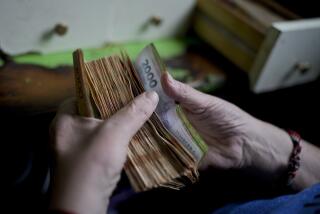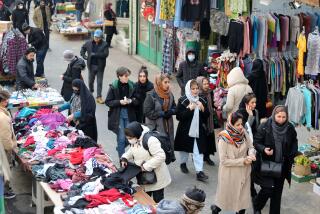Iranian bank note stirs chain reaction
- Share via
TEHRAN — A new 50,000-rial note going into circulation this week was meant to showcase Iran’s technological ambitions and boost national pride just before the Persian New Year next week.
Instead, illustrated with the image of an atom surrounded by a field of electrons over the map of Iran, the bill has proved immensely controversial.
It emerges as world powers are discussing the imposition of sanctions on Tehran over its uranium enrichment program and Iranian President Mahmoud Ahmadinejad is requesting an audience with the United Nations Security Council in a bid to allay international worries.
Among the Iranians it was meant to exalt, the bill elicited mostly worry and anger Tuesday.
“The bank note is a window display of a country just like a business card for a manager,” said Mustafa Hasanzadeh, a 52-year-old Tehran businessman. “This bill is the worst promotion for the Ahmadinejad government. If his government wants to compromise on the nuclear issue, this is a disgrace.”
A compendium of Iranian nationalist ambitions and symbols fills the back of the bill. The map of Iran with the atomic imagery is set above the words “Persian Gulf” written in English, a poke at Gulf Arabs who have begun claiming the oil-rich body of water as part of the Arab world.
Although some Iranians proudly hailed the bill as an emblem of national pride, others said it unnecessarily risked provoking world anger.
“It indicates Iranians are determined to have access to all kinds of sciences, but it also bears a defiant tone toward the international community,” complained Jangalbaye Vaqari, 34, a Tehran taxi driver.
Worth about $5.40, the new bank note is the highest denomination currency in circulation. Not only does it celebrate the nation’s step into the nuclear age, but it also could help replace the huge wads of cash people need to carry around to purchase basic goods.
But economists worldwide tend to agree that issuing larger-denomination bills indicates runaway inflation.
Most Iranians, especially those who remember the days in the 1970s when the rial traded at 70 to the dollar instead of today’s rate of about 9,300, fretted more over what the new currency means for their nation’s purchasing power than nuclear power.
“It looks beautiful,” said Hossein Samadzadeh, an accountant who saw pictures of the bill in a newspaper. “But regrettably it shows the devaluation [of our money] and is ominous.”
Like almost all Iranian currency, the new note bears an image on the front of Grand Ayatollah Ruhollah Khomeini, the late founder of Iran’s Islamic government. The cleric once remarked that the Islamic Revolution was about religion and “not about the price of watermelons.”
But as Iranian shoppers rush to buy food and gifts to celebrate the upcoming holidays, the price of watermelons is very much on the public’s mind.
“How can we be proud of our economy when we officially devaluate our own currency? The people first of all need decent jobs and food and then they can envisage something like national pride,” said Abul-Ghassem Goulbaf, a magazine publisher.
More to Read
Sign up for Essential California
The most important California stories and recommendations in your inbox every morning.
You may occasionally receive promotional content from the Los Angeles Times.










